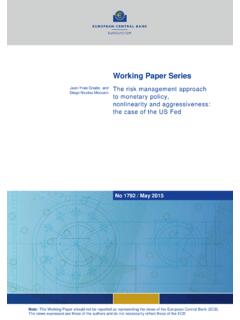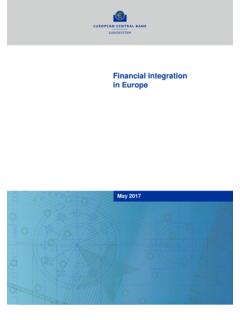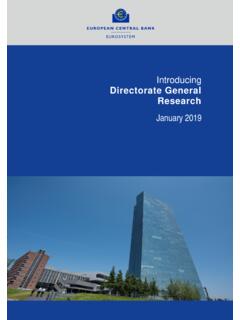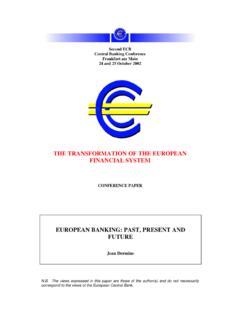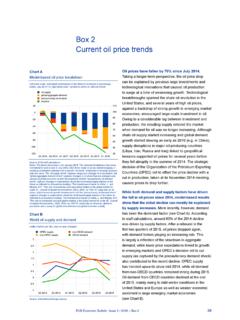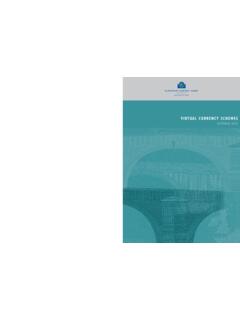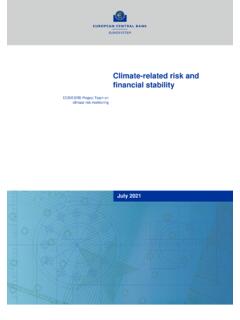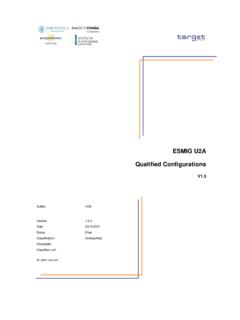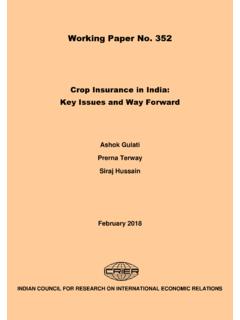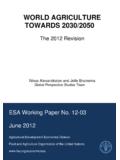Transcription of Working Paper Series - ecb.europa.eu
1 Working Paper Series Non-base wage components as a source of wage adaptability to shocks: evidence from European firms, 2010-2013 Wage Dynamics Network Jan Babeck , Cl mence Berson, Ludmila Fadejeva, Ana Lamo, Petra Marotzke, Fernando Martins, Pawe Strzelecki Disclaimer: This Paper should not be reported as representing the views of the European Central Bank (ECB). The views expressed are those of the authors and do not necessarily reflect those of the ECB. No 2158 / June 2018 Wage dynamics network This Paper contains research conducted within the Wage Dynamics Network (WDN). The WDN is a research network comprising economists from the European Central Bank (ECB) and the national central banks (NCBs) of the EU countries. It aims to study in depth the features and sources of wage and labour cost dynamics and their implications for monetary policy. The WDN initially operated from 2006 to 2009 and resumed activities, in part, from 2013-2017. The WDN s most recent research focus is to assess labour market adjustments in the period 2010-13 and firms reactions to the labour market reforms which took place over this period in EU Member States.
2 For this purpose, in 2014 the network launched an ad hoc survey of firms called the WDN3 survey . The refereeing of this Paper was coordinated by Juan J. Jimeno (Banco de Espa a, chairperson), Jan Babeck ( esk n rodn banka), Mario Izquierdo (Banco de Espa a), Stephen Millard (Bank of England), Tairi R m (Eesti Pank), Thomas Math (Banque centrale du Luxembourg), and Eliana Viviano (Banca d Italia). The Paper is hereto released in order to make the results of WDN s research widely available, in preliminary form, to encourage comments and suggestions prior to final publication. The views expressed in the Paper are those of the authors and do not necessarily reflect those of the ESCB. ECB Working Paper Series No 2158 / June 20181 Abstract This Paper provides evidence on the role of non-base wage components as a channel for firms to adjust labour costs in the event of adverse shocks. It uses data from a firm-level survey for 25 European countries that covers the period 2010 2013.
3 We find that firms subject to nominal wage rigidities, which prevent them from adjusting base wages, are more likely to cut non-base wage components in order to adjust labour costs when needed. Firms thus use non-base wage components as a buffer to overcome base wage rigidity. We further show that while non-base wage components exhibit some degree of downward rigidity, they do so to a lesser extent than base wages. JEL Codes: J30, J32, C81, P5 Keywords: downward nominal wage rigidity, bonuses, firm survey, European Union ECB Working Paper Series No 2158 / June 20182 Non-technical summary Micro-level data on wage variations and survey-based evidence on wage setting have revealed that even in the face of large negative shocks, not only are workers reluctant to accept cuts in their nominal wages, but also firms seem to be unwilling to carry out such cuts. This is referred to as downward nominal wage rigidity (DNWR). The resistance to cutting wages when economic conditions justify it in favour of freezing them is of course a major impediment to labour cost adjustment.
4 In the presence of DNWR, a positive rate of inflation is needed to facilitate the adjustment of relative wages. Hence, an inflation rate which is too low could lead, in the presence of DNWR, to long-term unemployment. However, the relevance of DNWR depends on whether firms have other margins besides base wages to adjust labour costs when needed. It is possible that rigidity has little effect on aggregate employment simply because firms have made adjustments that could be reflected in variables such as profits or productivity. Another possible explanation for the decorrelation between employment and DNWR is that firms may be able to achieve the necessary flexibility that is prevented by nominal wage rigidity by using more flexible pay components, such as performance-related bonuses, commissions and other benefits. Even though employees are less likely to oppose changes in these benefits than in their wages, from firms perspective they are also labour costs.
5 That is why the key point when analysing DNWR is whether firms can flexibly adjust total compensation as a whole. It could be the case that the effective degree of DNWR turns out to be lower when one accounts for total compensation, leading to a smaller sacrifice ratio and reduced bending of the Phillips curve. This Paper examines the issue of substitutability and complementarity between the base and non-base wage components raised in the literature. In particular, the Paper assesses the role of non-base wage components as a channel of labour cost adjustment in firms facing adverse economic shocks during 2010 2013. It firstly focuses on the relationship between wage rigidities and the use of non-base wage component adjustment. It then analyses the differences in the responses of base wages and non-base wages to shocks. We use a unique dataset based on a survey of firms from 25 European Union countries undertaken between the end of 2014 and mid-2015 as part of the third wave of the Wage Dynamics Network a Eurosystem research network created in 2006 and reactivated in 2013 with the main purpose of assessing labour market adjustments in the period 2010 2013.
6 The main results are the following. About 74% of firms covered in our sample paid bonuses and other performance-related benefits (non-base wage components) in 2013, with an average share of non-base wage components in the total wage bill in 2013 of around 7%. This is lower than in the pre-crisis period (11%). The smaller fraction of non-base wage components in the total wage bill may reflect the slower economic growth in 2013 relative to the pre-crisis period (2002 2007), but it is also suggestive of an increased role of these payments in firms labour cost flexibility, as reflected in a higher share of firms using non-base wages as part of their remuneration mechanisms. There is significant heterogeneity in the use of non-base wage reductions by sector and size for firms negatively affected by the economic conditions. A total of 13% of firms cut non-base wage components during 2010 2013, which is substantially larger than the percentage that cut base wages (5%).
7 This is not surprising for the majority of countries given the prevalence of DNWR. ECB Working Paper Series No 2158 / June 20183 The results indicate that firms that are subject to nominal wage rigidities are more likely to cut non-base wages in order to adjust labour costs in the presence of shocks. Thus, bonuses and benefits played a role as shock absorbers during the period 2010 2013. While firms which experience a fall in demand are more likely to reduce both base wages and non-base wage components than those that do not suffer any shock, we find that the increase in the probability of reducing non-base wages is higher than that of reducing base wages. Similarly, other negative shocks consistently generate negative effects on wages, with non-base wage components reacting more strongly than base wages to negative shocks. Our evidence also suggests that non-base wage components react more frequently in the case of negative shocks, and these reactions are stronger for non-base wage components than for base wages.
8 ECB Working Paper Series No 2158 / June 201841. Introduction Micro-level data on wage variations and survey-based evidence on wage setting have revealed that even in the face of large negative shocks, not only are workers reluctant to accept cuts in their nominal wages, but also firms seem to be unwilling to carry out such cuts. In some countries, these are quite difficult to implement or even forbidden due to labour legislation. This is referred to as downward nominal wage rigidity (DNWR). The restrictions on nominal wage cuts when economic conditions justify them in favour of wage freezes are of course a major impediment to labour cost adjustment. Besides legal constraints, several reasons have been given in the literature for workers and employers resistance to wage cuts. In addition to leading to lower standards of living for workers, such cuts may be considered unfair or demeaning by workers, with subsequent consequences for productivity.
9 Stiglitz (1986) puts forward two main economic explanations for the presence of DNWR: the implicit contract theory, which exploits the role of wages as an insurance-providing mechanism against fluctuations in the cost of living, and the efficiency wage model, according to which wages are regarded as a productivity-enhancing device. Akerlof and Yellen (1990), Bewley (1999), Agell and Lundborg (2003) and Babeck et al. (2010), among others, confirm the importance of fairness and efficiency considerations in preventing wage cuts. The empirical evidence on the prevalence of DNWR is also vast and is based mainly on the analysis of changes in the wage growth distribution. In the , clear signs of resistance to nominal wage cuts are found in studies such as Kahn (1997), Altonji and Devereux (2000) and Lebow et al. (2003). More recently, a comprehensive cross-country study conducted as part of the International Wage Flexibility Project has also revealed the existence of nominal wage rigidity in many European countries (Dickens et al.)
10 , 2007). Babeck et al. (2010) provide survey-based evidence on downward wage rigidity and its determinants for EU countries during times of economic stability; Fabiani et al. (2010), Izquierdo et al. (2017) and Marotzke et al. (2017) find that DNWR was prevalent in EU countries even in the strongest phases of the recent crisis. The extent and implications of DNWR are one of the key long-standing debates in macroeconomics. The issue goes back to Tobin (1972), who argued that DNWR induces a long-term trade-off between inflation and unemployment. In the presence of DNWR, a positive rate of inflation is needed to facilitate the adjustment of relative wages, in particular in recessions. Hence, an inflation rate which is too low could lead, in the presence of DNWR, to long-term unemployment. Subsequent theoretical research has formalised Tobin s argument in the context of the Phillips curve, which plots the average inflation rate against the average unemployment rate (Akerlof et al.
